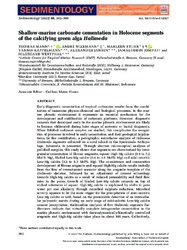Shallow‐marine carbonate cementation in Holocene segments of the calcifying green alga Halimeda
Wizemann, André
Kappelmann, Yannis
Janßen, Alexander
Jompa, Jamaluddin
Westphal, Hildegard
DOI: https://doi.org/10.1111/sed.12927
Persistent URL: http://resolver.sub.uni-goettingen.de/purl?gldocs-11858/9830
Persistent URL: http://resolver.sub.uni-goettingen.de/purl?gldocs-11858/9830
Supplement: https://doi.pangaea.de/10.1594/PANGAEA.923980
Mann, Thomas; Wizemann, André; Stuhr, Marleen; Kappelmann, Yannis; Janßen, Alexander; Jompa, Jamaluddin; Westphal, Hildegard, 2021: Shallow‐marine carbonate cementation in Holocene segments of the calcifying green alga Halimeda. In: Sedimentology, Band 69, 1: 282 - 300, DOI: 10.1111/sed.12927.
 |
Dokument öffnen: |
Early‐diagenetic cementation of tropical carbonates results from the combination of numerous physico‐chemical and biological processes. In the marine phreatic environment it represents an essential mechanism for the development and stabilization of carbonate platforms. However, diagenetic cements that developed early in the marine phreatic environment are likely to become obliterated during later stages of meteoric or burial diagenesis. When lithified sediment samples are studied, this complicates the recognition of processes involved in early cementation, and their geological implications. In this contribution, a petrographic microfacies analysis of Holocene Halimeda segments collected on a coral island in the Spermonde Archipelago, Indonesia, is presented. Through electron microscopical analyses of polished samples, this study shows that segments are characterized by intragranular cementation of fibrous aragonite, equant High‐Mg calcite (3.9 to 7.2 Mol% Mg), bladed Low‐Mg calcite (0.4 to 1.0 Mol% Mg) and mini‐micritic Low‐Mg calcite (3.2 to 3.3 Mol% Mg). The co‐existence and consecutive development of fibrous aragonite and equant High‐Mg calcite results initially from the flow of oversaturated seawater along the aragonite template of the Halimeda skeleton, followed by an adjustment of cement mineralogy towards High‐Mg calcite as a result of reduced permeability and fluid flow rates in the pores. Growth of bladed Low‐Mg calcite cements on top of etched substrates of equant High‐Mg calcite is explained by shifts in pore water pH and alkalinity through microbial sulphate reduction. Microbial activity appears to be the main trigger for the precipitation of mini‐micritic Low‐Mg calcite as well, based on the presumable detection of an extracellular polymeric matrix during an early stage of mini‐micrite Low‐Mg calcite cement precipitation. Radiocarbon analyses of five Halimeda segments furthermore indicate that virtually complete intragranular cementation in the marine phreatic environment with thermodynamically/kinetically controlled aragonite and High‐Mg calcite takes place in about 100 years. Collectively, this study shows that early‐diagenetic cements are highly diverse and provides new quantitative constraints on the rate of diagenetic cementation in tropical carbonate factories.
Statistik:
ZugriffsstatistikSammlung:
Schlagworte:
Cementation ratelow‐Mg calcite cementation
marine diagenesis
microbial sulphate reduction
permeability
porosity
tropical carbonates
This is an open access article under the terms of the Creative Commons Attribution License, which permits use, distribution and reproduction in any medium, provided the original work is properly cited.

